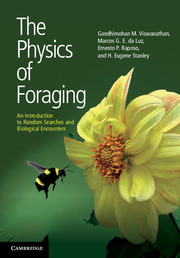7 - Human dispersal
from Part II - Experimental findings
Published online by Cambridge University Press: 05 August 2012
Summary
This chapter reviews the evidence in favor of anomalous diffusion in the movement of human beings. Human diffusion constitutes a driving force for various spatiotemporal phenomena that occur on large geographical scales [52], and can synchronize and stabilize populations as well as diversify gene pools.
The spread of infectious disease, for example, depends on human diffusion. Consider, for example, the spread of swine flu (H1N1 influenza A [56]), resulting in the World Health Organization raising the pandemic alert to phase 6 – the highest level – in June 2009, only a few months after the virus's first appearance in Mexico. It is difficult to model or understand the pandemic in terms of normal diffusion or the kinds of wave fronts seen in solutions of the standard (i.e., nonfractional) Fisher-Kolmogorov equation. The virus appears to jump across continents and oceans in a very short time, in a manner more commensurate with superdiffusion than with normal diffusion. Similarly, the 1918 flu pandemic (Spanish flu) lasted only a couple years but reached nearly all corners of the planet with a rapidity consistent with a superdiffusive process mediated by human mobility.
Given the role of human diffusion – or superdiffusion – in pandemics and other reaction-diffusion processes, we now examine how humans diffuse. Because we assume that air, sea, and highway transportation increase mobility and diffusivity, we begin by looking at human societies that predate those modern modes of travel.
Information
- Type
- Chapter
- Information
- The Physics of ForagingAn Introduction to Random Searches and Biological Encounters, pp. 64 - 70Publisher: Cambridge University PressPrint publication year: 2011
